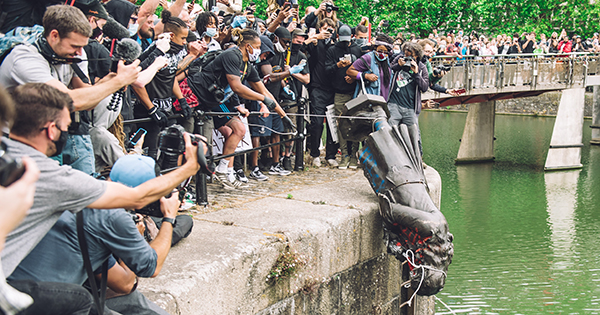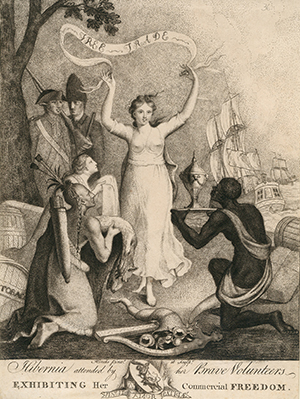Clean hands? Ireland, slavery and the slave-trade
Published in Issue 5 (September/October 2020), Platform, Volume 28Ireland’s record as regards the slave-trade is far from unblemished.
By Laurence Fenton
While calls for the removal of a plaque honouring the Galway-born Confederate army officer Dick Dowling from Tuam Town Hall and uncomfortable murmurings about the name of La Touche House in Dublin’s International Financial Services Centre show that Ireland has not been immune to the worldwide furore over slavery-related iconography, there remains a sense that the country as a whole has pretty clean hands in this area. Certainly, there’s little chance of the statues bestriding the central thoroughfares of Ireland’s major cities following Bristol’s Edward Colston into the river or being whisked away into storage in the dead of night. Nevertheless, Ireland’s relationship with slavery and the slave-trade was far from unblemished. In its most blatant manifestation, a number of slaves were still being held in the country up to the mid-eighteenth century and the famous Somerset case. Brought over from the Americas or the Caribbean, they may not have been subjected to the terrible conditions of slaves in their countries of origin but they were still denied the same rights as their white owners—still referred to and seen as property. ‘A Negro Boy and Slave, called Brazill, the property of William Nicholson, Esq., has been missing since Thursday evening last’, ran one notice in a Dublin newspaper in 1756. ‘Run away from the service of Mrs Fullerton of Carrickfergus, on Sunday last, a Negro slave boy’, read another a few years later. The claim by the great Irish leader and prominent anti-slavery advocate Daniel O’Connell that no slave ship ever left Ireland’s shores was also mistaken. They may have been illegal and in the distant past, but they certainly existed; the last recorded Irish slave ship, the Prosperity from Limerick, sailed into Barbados on 31 July 1718 with 96 slaves aboard.

Above: The statue of slave-trader Edward Colston being pushed into the River Avon in Bristol on 7 June 2020. (Getty Images)
It is important to note that it was legislation rather than moral scruples that kept the Irish from getting even more intimately involved in the slave-trade—a series of Navigation Acts passed by the Westminster parliament in the seventeenth and eighteenth centuries prioritised British ports and vessels over their Irish counterparts and denied Irish merchants the right to trade directly with the West Indies in goods such as sugar or slaves. Essentially, Britain’s subjugation of Ireland kept the country out of the slave-trade, kept Ireland from subjugating others. This is a facet of Ireland’s relationship with slavery and the slave-trade that seems not to have been noticed in the myriad of opinion pieces and articles published in the Irish press in the aftermath of the brutal killing of George Floyd. The Irish abroad—be it in the Caribbean, the American South or, as was the case for the Walshes, Sarsfields and other Wild Geese, in the slave-trading French port of Nantes—certainly had little compunction about participating in and benefiting from the enslavement of captured Africans. Indeed, it is very easy to imagine an alternative history in which port cities like Dublin and Cork (especially Cork, with its strategic position as the last stop before America) became as enmeshed with slave money as Bristol or Glasgow, and where the main business at today’s City Hall meetings would be the contentious renaming of streets, public spaces, arts venues and other institutions.
Despite the limitations on what they could trade, many Irish merchants became rich supplying the British, French and Dutch islands of the Caribbean with provisions (the islands themselves focused solely on the production of cash crops such as sugar, cotton, indigo and coffee). The port of Cork, in particular, owed much of its success in the eighteenth century to this trade, devising special techniques to ensure the preservation of its beef, butter and fish in high temperatures. The better-quality meat went straight to the plates of the plantation owners, while the slaves made do with ‘cow beef’—the carcasses of elderly dairy cattle, specially fattened and cut up into small pieces. Belfast, too, had strong links with the Caribbean, supplying the coarse linen and shoes with which plantation-owners clothed their slaves. Some of these merchants, like the Blakes from Galway and the Creaghs from Limerick, went on to settle in the Caribbean; a David Creagh, for example, purchased a plantation in Barbados in the early eighteenth century, for which he bought more than 200 slaves for c. £25 a head. Bankers, too, got involved—the la Touche family, for example, founding shareholders of the Bank of Ireland, owned slaves in Jamaica—as did many others from the ranks of the professionals. Indeed, University College London’s ground-breaking ‘Legacies of British Slave Ownership’ database is replete with the names of Irish men and women—from Cobh to Coleraine and from Sligo to Swords—who benefited financially when the British government abolished slavery in 1833, with estimates suggesting that the Irish-born or Irish-domiciled slave-owners received an £800,000 slice of the £20 million (£1.4 billion in today’s money) compensation pie.

Above: ‘Hibernia attended by her Brave Volunteers, Exhibiting Her Commercial Freedom’—1780 print by William Hincks. ‘Free trade’ also meant freedom to enter the slave-trade. (NLI)
When trade restrictions were eased in the late eighteenth century, a number of Irish businessmen tried to get the country more directly involved in the slave-trade, with a plan announced for the establishment of an ‘African company’ in Limerick in 1784. Six ships would be employed annually, carrying firearms, linen, cottons, soap, candles and even ‘Dutch toys’ to the slave coast of West Africa, where in true triangular-trade style they would be exchanged for hundreds of slaves, who would in turn be traded in the West Indies for sugar, coffee and other tropically grown goods. A similar proposal was mooted for Belfast a year later. The growing anti-slavery sentiment across Britain and Ireland at the time, however, ensured that neither venture took off. ‘May God eternally damn the soul of the man who subscribes the first guinea,’ wrote the radical watchmaker and United Irishman Thomas McCabe of the Belfast plan.
Daniel O’Connell and Fr Mathew, the iconic figures looking down from their mighty plinths on the denizens of Dublin and Cork respectively, both met Frederick Douglass when the famous American former slave visited Ireland in 1845. Douglass’s tour, the details of which have become well known in recent years, shows Ireland in a generous, welcoming light. Nevertheless, the celebration of the reception that the country afforded the refugee Douglass has always seemed somewhat self-serving, especially when contrasted with the starkly different experience awaiting asylum-seekers and refugees in the present day. The fact that the direct provision system is scheduled to be abolished within the lifetime of the new government is of little solace to those who have endured its miseries over the last twenty years. It is also deeply ironic that the building in which the refugee Douglass met O’Connell in September 1845 now houses the Garda Immigration Bureau, where deportees are processed before being sent out of the country—to who knows what fate?
At this historic juncture, when much of the western world is finally facing some sort of reckoning for its slavery-tainted past, be it American cities taking down statues of Confederate generals or British businesses like Lloyds of London accepting the need to pay reparations, it would be misguided for Ireland to get too complacent or self-congratulatory about its own place in this most odious of tales.
Laurence Fenton is a writer and editor living in Cork.
















